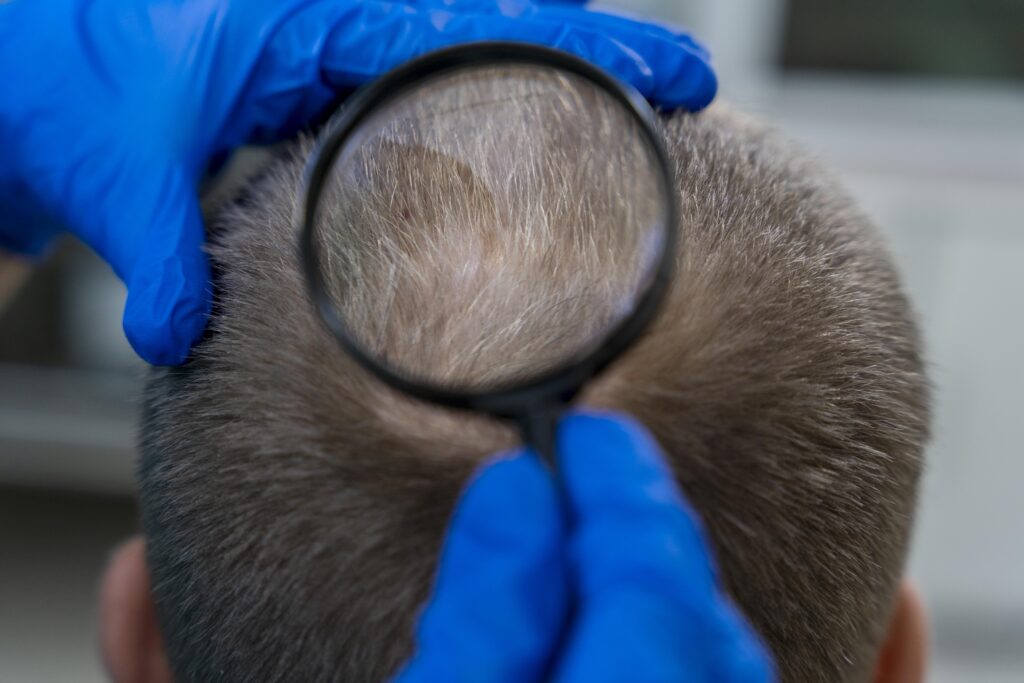Experiencing sudden hair loss in patches can be distressing. Alopecia areata, an autoimmune disorder, is a common cause of such patchy hair loss.
This article explores the latest and most effective alopecia areata medications, treatment options, expert insights, and real recovery advice—so you can make informed choices and regain control of your hair health with confidence.
Understanding Alopecia Areata
What Is Alopecia Areata?
Alopecia areata is an autoimmune condition where the immune system mistakenly attacks hair follicles, causing sudden, patchy hair loss.
While it primarily affects the scalp, it can also involve the eyebrows, eyelashes, and other body areas.

Causes and Risk Factors
- Genetics: A family history increases risk.
- Environmental triggers: Stress, infections, and allergens may trigger the onset.
- Associated conditions: More common in people with other autoimmune disorders like thyroid disease or vitiligo.
Types of Alopecia Areata
- Patchy: Small, round bald spots on the scalp or body.
- Alopecia Totalis: Complete loss of scalp hair.
- Alopecia Universalis: Total loss of body hair.
- Ophiasis: Hair loss in a band-like pattern around the scalp.
FDA-Approved Medications for Alopecia Areata
Janus Kinase (JAK) Inhibitors
Baricitinib (Olumiant)
- How it works: Blocks immune signaling pathways that attack hair follicles.
- Approved use: First oral medication FDA-approved for severe alopecia areata.
- Benefits: Clinical trials show over 30% hair regrowth in many patients.
- Risks: Includes acne, elevated cholesterol, or infection risk.
Ritlecitinib (Litfulo)
- Target group: Approved for patients aged 12 and older.
- Mechanism: Selectively inhibits JAK3 and TEC family kinases.
- Results: Encouraging regrowth rates in adolescents and adults.
- Side effects: Nausea, headache, and mild infections are most commonly reported.
Conventional Treatment Options
Corticosteroid Therapies
Topical Corticosteroids
- Applied directly to bald patches.
- Suitable for children and mild cases.
- Requires daily use over weeks or months.
Intralesional Corticosteroids
- Small injections into affected areas.
- Commonly used in dermatology clinics.
- Often results in hair regrowth within 4–6 weeks.
Systemic Corticosteroids
- Oral or intravenous.
- Reserved for rapidly progressing or widespread cases.
- Requires careful monitoring due to systemic side effects.
Topical Immunotherapy
- Uses agents like DPCP or SADBE to provoke mild allergic reactions that distract the immune system from attacking hair follicles.
- High success rate in severe or treatment-resistant cases.
- May cause scalp irritation or pigmentation changes.
Other Medications
- Methotrexate: Immunosuppressive; used off-label.
- Cyclosporine: Effective but with serious side effect risks.
- Usually prescribed only when first-line therapies fail.
Emerging and Complementary Therapies
Platelet-Rich Plasma (PRP) Therapy
- Involves injecting a concentration of your platelets into the scalp.
- Encourages hair follicle regeneration and reduces inflammation.
- Results may take 3–6 sessions for visible improvement.

Low-Level Laser Therapy (LLLT)
- Devices emit red light to stimulate follicles.
- FDA-cleared for hair loss in both men and women.
- Painless, at-home options are available.
Nutritional and Lifestyle Interventions
- Diet: Focus on iron, biotin, zinc, and protein-rich foods.
- Stress management: Yoga, mindfulness, and therapy can reduce immune overactivity.
- Supplements: Vitamin D, omega-3, and adaptogens may support recovery.
Recovery Timeline and Expectations
Typical Progression of Hair Regrowth
- Topical steroids: 1–3 months.
- JAK inhibitors: 3–6 months for visible results.
- Immunotherapy: 4–12 months, with possible relapses.

Managing Relapses
- Alopecia areata often recurs.
- Regular follow-ups and early treatment can reduce severity.
- Combining therapies (e.g., JAK + PRP) may enhance long-term outcomes.
Pro Tip: Track your symptoms monthly and consult your doctor at the first sign of new patch formation.
Expert Insights and Patient Experiences
Dermatologist Recommendations
“Combination therapy offers the best chance of sustained regrowth, especially in chronic cases,” says Dr. Rana Irfan, Hair Restoration Specialist in Islamabad.
- Start with corticosteroids for acute flare-ups.
- Move to JAK inhibitors if no improvement in 3–6 months.
- Consider adjuncts like PRP and immunotherapy for persistent cases.
Real-Life Patient Stories
- Sara, 29: Saw hair regrowth after 5 months of topical immunotherapy.
- Hamza, 17: Responded well to Litfulo with minimal side effects.
- Many patients report emotional challenges—support groups and counseling make a difference.
Frequently Asked Questions (FAQs)
Is alopecia areata contagious?
No, it’s an autoimmune condition and cannot be spread between people.
Can children develop alopecia areata?
Yes, it can appear at any age, even in early childhood.
Are there any effective natural remedies?
Some people benefit from stress reduction, anti-inflammatory diets, and supplements, but these are not substitutes for medical treatment.
How do I choose the right treatment?
It depends on severity, age, and prior response. A dermatologist can help personalize your plan.
What should I expect during treatment?
Expect gradual progress, with potential relapses. Patience and consistency are key.
Consult with Our Specialists in Islamabad
Struggling with sudden hair loss? Let our expert dermatology team help. Whether you’re new to alopecia areata or looking for advanced treatment options like JAK inhibitors or PRP, we’ll guide your recovery.
Schedule Your Appointment Today
Book your consultation with Dr. Rana Irfan and get a personalized plan that fits your condition and lifestyle.
📍 Book a Consultation – Dr Rana Irfan Islamabad Clinic
📞 Call now or fill out our online appointment form.
